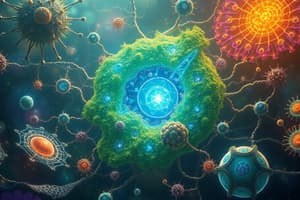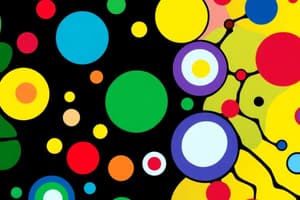Podcast
Questions and Answers
Which factor is considered abiotic in an ecosystem?
Which factor is considered abiotic in an ecosystem?
- Plants
- Predators
- Climate (correct)
- Symbiotic relationships
What is the primary process through which humans liberate energy from food?
What is the primary process through which humans liberate energy from food?
- Cellular respiration (correct)
- Digestion
- Fermentation
- Photosynthesis
Which group (taxon) is the highest in the classification hierarchy?
Which group (taxon) is the highest in the classification hierarchy?
- Family
- Domain (correct)
- Species
- Genus
How does energy transfer through a food chain typically affect the amount of energy at each trophic level?
How does energy transfer through a food chain typically affect the amount of energy at each trophic level?
Which system is responsible for coordinating responses to internal and external stimuli in the human body?
Which system is responsible for coordinating responses to internal and external stimuli in the human body?
Which of the following characteristics are essential to distinguish living organisms from non-living matter?
Which of the following characteristics are essential to distinguish living organisms from non-living matter?
What is the primary function of transcription in the context of genetics?
What is the primary function of transcription in the context of genetics?
Which of the following best describes the difference between prokaryotic and eukaryotic cells?
Which of the following best describes the difference between prokaryotic and eukaryotic cells?
What is the role of mutations in genetics?
What is the role of mutations in genetics?
What process produces gametes with half the number of chromosomes?
What process produces gametes with half the number of chromosomes?
Which statement about natural selection is accurate?
Which statement about natural selection is accurate?
What is the fundamental understanding of common ancestry in evolutionary biology?
What is the fundamental understanding of common ancestry in evolutionary biology?
In the levels of biological organization, which of the following comes first in the hierarchy?
In the levels of biological organization, which of the following comes first in the hierarchy?
Flashcards
Biology Definition
Biology Definition
The study of life and living organisms.
Cell Theory
Cell Theory
All living things are made of cells; cells come from pre-existing cells; cells are the basic unit of life.
Prokaryotic Cell
Prokaryotic Cell
A cell without a nucleus or membrane-bound organelles.
Eukaryotic Cell
Eukaryotic Cell
Signup and view all the flashcards
Levels of Organization
Levels of Organization
Signup and view all the flashcards
Heredity
Heredity
Signup and view all the flashcards
Evolution
Evolution
Signup and view all the flashcards
DNA
DNA
Signup and view all the flashcards
Ecology definition
Ecology definition
Signup and view all the flashcards
Trophic Levels
Trophic Levels
Signup and view all the flashcards
Classification Systems
Classification Systems
Signup and view all the flashcards
Abiotic Factors
Abiotic Factors
Signup and view all the flashcards
Cellular Respiration
Cellular Respiration
Signup and view all the flashcards
Study Notes
Basic Biological Principles
- Biology is the study of life, encompassing a vast range of organisms and their interactions with each other and the environment.
- Key characteristics of living organisms include: organization, metabolism, growth and development, adaptation, response to stimuli, reproduction, and homeostasis.
- These characteristics distinguish living entities from non-living matter.
Cell Theory
- All living organisms are composed of cells.
- Cells are the basic structural and functional units of life.
- All cells arise from pre-existing cells.
Levels of Biological Organization
- Atoms combine to form molecules.
- Molecules assemble to form macromolecules.
- Macromolecules interact to form organelles.
- Organelles work together to form cells.
- Similar cells unite to create tissues.
- Tissues combine to form organs.
- Organs work together as organ systems.
- Organ systems, collectively, compose the entire organism.
Prokaryotic vs. Eukaryotic Cells
- Prokaryotic cells (e.g., bacteria) lack a nucleus and membrane-bound organelles.
- Eukaryotic cells (e.g., plants, animals) contain a nucleus and various membrane-bound organelles like mitochondria, endoplasmic reticulum, and Golgi apparatus.
- These differences reflect the complexity and evolutionary history of life.
Genetics and Heredity
- Heredity is the transmission of traits from parents to offspring.
- Deoxyribonucleic acid (DNA) is the hereditary material.
- Genes, segments of DNA, determine traits.
- Genetic information dictates the synthesis of proteins.
- The process of transcription converts DNA into RNA, which in turn guides protein synthesis during translation.
- Mitosis and meiosis are the two primary cell division mechanisms.
- Mitosis produces identical daughter cells for growth and repair.
- Meiosis produces gametes (sex cells) with half the number of chromosomes for sexual reproduction.
- Mutations can arise from errors during DNA replication or exposures to mutagenic agents, potentially leading to variations in traits and susceptibility to diseases.
Evolution
- Evolution is the change in heritable characteristics of biological populations over successive generations.
- Natural selection is a key mechanism of evolution, where advantageous traits increase in frequency over time.
- Evolutionary relationships among organisms are demonstrated in phylogenetic trees.
- Common ancestry is a fundamental concept of evolutionary biology.
Ecology
- Ecology examines the interactions between organisms and their environment.
- Organisms within an ecosystem are connected by various relationships, like predation and symbiosis.
- Communities of organisms interact with physical factors to form distinct ecosystems.
- Biomes, large-scale ecosystems categorized by climate and vegetation, display biodiversity of species and populations.
- Abiotic (non-living) factors such as climate, sunlight, and water availability significantly impact ecosystems.
- Understanding ecological relationships is important for conservation efforts.
Organisms and their classification
- Classification systems organize the diversity of life into hierarchical groups, ranging from domains to species.
- Modern classification systems reflect evolutionary relationships.
- Different ways of classifying and naming organisms based on evolutionary relationships and shared characteristics, using universally accepted taxonomic names.
- Common taxa include: kingdoms, phyla, classes, orders, families, genera, and species.
Energy flow in ecosystems
- Energy flows through ecosystems via food chains/webs, beginning with producers (autotrophs) and passing through several trophic levels.
- Energy is lost as heat with each transfer in the food chain.
- Nutrients cycle through an ecosystem—from the environment to organisms and back—often in complex processes involving decomposers.
Human Biology
- Human biology focuses on the structure, function, and development of the human body.
- Understanding human biological processes is crucial for wellness and disease prevention.
- The nervous and endocrine systems coordinate responses within the body.
- The immune system defends against pathogens.
- Cellular respiration is the primary process used by humans to liberate energy from food for bodily functions.
Studying That Suits You
Use AI to generate personalized quizzes and flashcards to suit your learning preferences.




